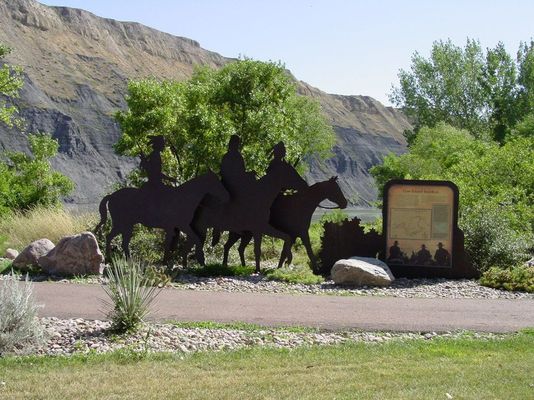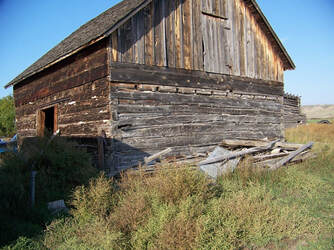LOCALLY Powered
 Sculptures pay tribute to the Nez Perce & to Fort Benton as a "Contributing Site"
on the Nez Perce (Nee-Me-Poo) National Historic Trail
Sculptures pay tribute to the Nez Perce & to Fort Benton as a "Contributing Site"
on the Nez Perce (Nee-Me-Poo) National Historic Trail
The Big Sky Country National Heritage Area is an all-volunteer nonprofit formed to establish the first National Heritage Area (NHA) in Montana. National Heritage Areas are places where historic, cultural, and natural resources combine to form cohesive, nationally important landscapes. Unlike national parks, National Heritage Areas are large lived-in landscapes. Consequently, National Heritage Area entities collaborate with communities to determine how to make heritage relevant to local interests and needs. There are 62 designated National Heritage Areas in 36 states across the country that support a diversity of conservation, recreation, education, and preservation activities.
In 1984, the first National Heritage Area, Illinois and Michigan Canal National Heritage Area, was signed into law by President Ronald Reagan. In his dedication speech, Reagan referred to National Heritage Areas "a new kind of national park" that married heritage conservation, recreation, and economic development. (See https://www.nps.gov/subjects/heritageareas/discover-nhas.htm for more information.)
Our area is particularly blessed to have four National Historic Landmarks! For more info these landmarks, check out these websites: see the C.M. Russell Museum and Studio National Historic Landmark, Fort Benton National Historic Landmark, the Great Falls Lewis and Clark Great Falls Portage National Historic Landmark, and the First People's Buffalo Jump National Historic Landmark.
We are working collaboratively with local communities to define this nationally significant landscape along the Missouri River, from Fort Benton through Cascade County, as a National Heritage Area. The designation is honorary.
Although Congressional designation provides eligibility for competitive modest federal funding, the Heritage Area is locally powered and managed by a Board of Directors and largely dependent on locally raised funding. All funds raised will be used to promote economic development and tourism within the Upper Missouri River area.
The federal legislation will have NO impact on private property rights. It does NOT require property owners to permit public access to his or her property or modify any provisions with regard to public access or use of private lands. A National Heritage Area is NOT a government land grab. The National Park Service does NOT manage the Heritage Area. The heritage area will be a nonprofit organization run by your neighbors, friends and colleagues. Want to learn more about the economic impact of National Heritage Areas? Check out the Alliance for National Heritage Areas. For a closer look at a very successful Heritage Area that has had a huge economic impact on the Pittsburgh area, see Rivers of Steel.
In 1984, the first National Heritage Area, Illinois and Michigan Canal National Heritage Area, was signed into law by President Ronald Reagan. In his dedication speech, Reagan referred to National Heritage Areas "a new kind of national park" that married heritage conservation, recreation, and economic development. (See https://www.nps.gov/subjects/heritageareas/discover-nhas.htm for more information.)
Our area is particularly blessed to have four National Historic Landmarks! For more info these landmarks, check out these websites: see the C.M. Russell Museum and Studio National Historic Landmark, Fort Benton National Historic Landmark, the Great Falls Lewis and Clark Great Falls Portage National Historic Landmark, and the First People's Buffalo Jump National Historic Landmark.
We are working collaboratively with local communities to define this nationally significant landscape along the Missouri River, from Fort Benton through Cascade County, as a National Heritage Area. The designation is honorary.
Although Congressional designation provides eligibility for competitive modest federal funding, the Heritage Area is locally powered and managed by a Board of Directors and largely dependent on locally raised funding. All funds raised will be used to promote economic development and tourism within the Upper Missouri River area.
The federal legislation will have NO impact on private property rights. It does NOT require property owners to permit public access to his or her property or modify any provisions with regard to public access or use of private lands. A National Heritage Area is NOT a government land grab. The National Park Service does NOT manage the Heritage Area. The heritage area will be a nonprofit organization run by your neighbors, friends and colleagues. Want to learn more about the economic impact of National Heritage Areas? Check out the Alliance for National Heritage Areas. For a closer look at a very successful Heritage Area that has had a huge economic impact on the Pittsburgh area, see Rivers of Steel.
The Latest News
 Old Toman Barn, Sun River Crossing
Old Toman Barn, Sun River Crossing
The BSCNHA works to tell all the history of the region. Because Black Eagle and the Anaconda Smelter played such an important part in the wiring the early United States and in World War 2, the NHA has either carried out or supported two major projects preserving the history of that area. The first supports the City-County Historic Preservation Advisory Commission's work to stabilize the only remaining building from the Smelter - the Boston and Montana (Horse) Barn.
One of our 2023 projects included partnering with the City of Great Falls to help fund a plan to stabilize the last remaining industrial building from the Anaconda Smelter in Black Eagle, the Boston and Montana Barn. Our most recent project was to capture the oral history of the last plant manager at the Black Eagle Anaconda Smelter, Dick Sloan.
We also help local organizations accomplish their mission, in partnership with many other stakeholders. Our 2023 grant recipients included:
One of our 2023 projects included partnering with the City of Great Falls to help fund a plan to stabilize the last remaining industrial building from the Anaconda Smelter in Black Eagle, the Boston and Montana Barn. Our most recent project was to capture the oral history of the last plant manager at the Black Eagle Anaconda Smelter, Dick Sloan.
We also help local organizations accomplish their mission, in partnership with many other stakeholders. Our 2023 grant recipients included:
- Sun River Valley Historical Society/ Fort Shaw: Restoration of the old John Healy/ Tolman Barn, helping to creating footings after the original barn was moved from the Sun River Crossing to Fort Shaw. Created in the 1860s, the barn had stables and a blacksmith shop.
- Mandan Boat Repair, Phase II/ Fort Benton: The Mandan Boat Repair, done by the Fort Benton Community Improvement Association, focused on repairing the keelboat that appeared in the 1952 film, "The Big Sky." The keelboat was one of the vessels used by the Lewis and Clark Expedition as the traveled up the Missouri River.
- Brother Van Home Museum/ Great Falls: The museum hired a docent and assistant to lead tours of the museum during the summer of 2023, which resulted in over 114 visitors.
- International Games Society/ Great Falls: Funding helped the International Games Society to host a week-long Gathering of Families that highlighted and celebrated Montana's Native American culture, while bringing together members of all Montana tribes for family fun, traditional games, and cultural events in October 2023.
- Paris Gibson Square Museum of Art/ Great Falls: The Square received support for their bat remediation project, to help them ethically remove bats that had been roosting in their attic for nearly 50 years.
This website uses marketing and tracking technologies. Opting out of this will opt you out of all cookies, except for those needed to run the website. Note that some products may not work as well without tracking cookies.
Opt Out of Cookies